| IdeaXchg premium information resources |
|
|
|
AAO - Astronomical Images by David Malin at the Anglo-Australian Observatory A collection of astronomical photographs from telescopes of the Anglo-Australian Observatory by astronomer David Malin, using innovative imaging techniques to enhance color and bring out faint details. In addition to images from the 3.9m Anglo-Australian Telescope, the collection includes wide-field images taken with the 1.2m UK Schmidt Telescope, such as the Orion nebula shown at right. The full set of color images is presented as thumbnails in a series of summary pages, grouped by object type. These include 50+ all-time favorites, galaxies (by type), emission nebulae (by constellation), reflection nebulae, dark and dusty nebulae, planetary nebulae, supernova remnants, star clusters, unusual stars, and more. |
|
|
AlltheSky - Digital Images of the Sky by Till Credner and Sven Kohle An astrophotography site, notable for its exceptionally detailed, very wide-field, color photographs of the night sky. Systematic coverage of constellations includes of images in a range of sizes, with versions marked to highlight deep space objects, and a naked eye view with overlayed constellation lines. Additional content includes photos of comets, eclipses, star clusters, nebulae, galaxies, the atmosphere, observatories, and miscellaneous, with a page of thumbnails for each category. Under miscellaneous entries, note Sven Kohle's animated view of the local universe, showing the distribution of galaxies within a cube of 230 megalightyears. |
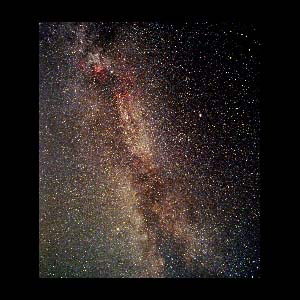 |
|
APOD - NASA's Astronomy Picture of the Day Every day, this site presents a spectacular new image on its home page, along with a brief explanation written by a professional astronomer. With an archive of past pages going back to June 16 1995, the articles are heavily interconnected and generously sprinkled with references to authoritative sources, making the site both entertaining and highly educational. There is an index of pages organized into the major categories of Cosmos, Solar System, Space Technology, People, and Sky, with a further breakdown into subheadings. For each subheading, a corresponding page displays thumbnails and descriptions of selected APOD entries in that category, chosen for having the greatest educational value. A text search form is also provided. |
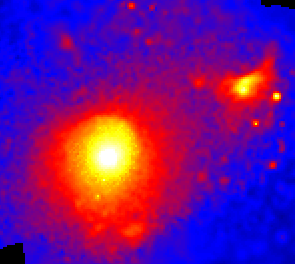
|
|
Dibon-Smith
- The Constellations This site has excellent charts of all 88 constellations, organized alphabetically, and also indexed by Messier object and NGC objects. Charts include an equatorial coordinate grid, constellation outlines, and concise markings of the principal stars with their Greek Bayer letters or Flamsteed numbers. Brighter stars, Messier objects, galaxies, and other prominent features are shown to a level of considerable detail, but avoiding excessive clutter, with each constellation presented at a scale appropriate to its size. There are write-ups for each constellation describing its mythological or other origin, and listing double stars, variable stars, and deep sky objects. Stellar data for the Bayer stars and orbits for 150 visual binaries are organized by constellation. Additional material includes introductory stargazing articles, binocular views of each constellation, and a table of 3700+ Draper and Hipparcos catalog references covering all of the Bayer and Flamsteed stars. |
|
|
HubbleSite - Home of NASA's Hubble
Space Telescope This is the public outreach site for the Hubble Space Telescope (HST), produced by the Space Telescope Science Institute (STScI), which serves the scientific community. The bulk of the site's content lies in the latest Hubble news releases and a searchable archive of all past releases dating back to 1990, broken down by category, year, and type of news. Each news release includes an informative piece of text and stunning graphics, provided in a range of sizes for convenient downloading. The HubbleSite gallery contains a collection of wallpaper and a showcase of representative images under the major headings of Solar System, Stars, Galaxies, Nebulae, Exotica, and Telescope. Additional sections include multimedia presentations, interactive games and activities, and supplementary educational content. |
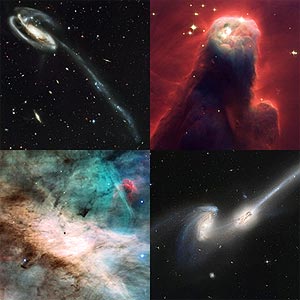
|
|
Kaler - Portraits of Stars and their Constellations A compendium of information about stars, constellations, and introductory explanations of scientific topics in astronomy, compiled by Jim Kaler, Prof. Emeritus of Astronomy at the University of Illinois. The site includes 100 constellation photographs, along with labeled versions (as shown at right), providing a naked eye views of 81 of the 88 constellations, plus detailed information about hundreds of prominent stars, organized by name, constellation, and spectral class. Among the other highlights there is a section of classical star atlas pages, and a very lucid, illustrated article on the coordinate system of the celestial sphere. Also note the detailed introductory articles on fundamental characteristics of stars, and stellar spectra. |
|
|
Mellinger - Axel Mellinger's All-Sky Milky Way Panorama This site is devoted to a composite image derived from 51 wide-angle photographs of the night sky, taken from locations around the world over a period of three years. Using digitized image processing and special transformations to eliminate camera lens distortion, two different all-sky projections have been meticulously constructed, one an Aitoff projection (as shown), and the other a an equidistant azimuthal (polar) projection. An expanded view of the central band comprising the Milky Way also is provided, with outlines and labels marking the constellations. Another feature is an associated interactive java applet for navigating a window into the full the image, with constellation markings and hot spots leading to related images. |
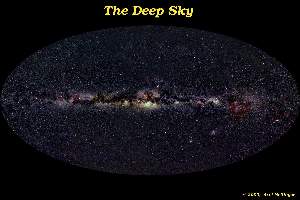 |
|
Multiwavelength Milky Way
- at NASA's Astronomical Data Center A brief, graphical introduction to multi-wavelength astronomy presenting multiple views of the entire Milky Way in different ranges of the electromagnetic spectrum. In one representation, as shown at right, a narrow band along the galactic plane is displayed at ten wavelengths, from radio waves to gamma rays. On the accompanying page for science users, you can zoom in to two levels of increased detail, and additional technical information is provided. Also there is a slide set of all-sky Aitoff projections, with images covering the whole sky at eight different wavelengths. An explanatory page includes each of these images, along with a brief description. |
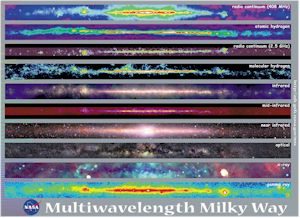 |
|
Powell - An Atlas of The Universe
This site offers an unusual perspective on cosmic distance scales, through a series of images depicting the known stars and galaxies within progressively larger spheres around the sun. Beginning at a radius of 12.5 light years (shown at right, containing the nearest 33 stars), successively larger spherical regions are charted, all the way up to the filaments and voids of the neighboring superclusters at 1 billion light years, and the entire visible universe within 14 billion light years. Each page contains information about objects and highlights at that scale, with links to catalog data, images, and related articles. In addition to the site's 3-D graphical content, there is detailed information about the more than 100 nearest stars within 20 light years, a map and list of nearby galaxies within 20 million light years, a list of nearby galaxy groups within 100 million light years, the nearest clusters and superclusters within 500 million light years, major superclusters within 2 billion light years, and many more pages and images of general interest. |
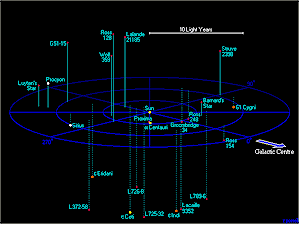 |
|
Princeton - The Galaxy Catalog, by Zsolt Frei and James E. Gunn A collection of digital images of 113 nearby galaxies, including color composites generated by combining images through separate filters. CCD equipped cameras were used to capture 31 galaxies with the 1.5 meter telescope of the Palomar Observatory in 1991, and the other 82 with the 1.1 meter telescope of the Lowell Observatory in 1989. High resolution graphics files are provided for each filter, in JPG and GIF, as well as corresponding header and FITS format, along with a compact composite color JPEG image for each galaxy. Also there is a page of thumbnail images, and a large poster (1.64 MB, 3730 X 2430 pixels). |
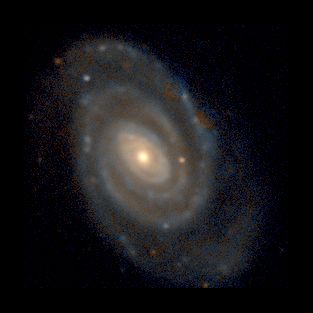 |
|
Virtual Sky - at Caltech's Center for Advanced Computing Research Virtual Sky is an interactive "virtual observatory" for rapidly navigating to any part of the sky and displaying images, at a wide range of magnifications. Its chief attraction is that it provides convenient access to optical images from the Digital Palomar Observatory Sky Survey (DPOSS), covering the entire northern sky at about 1 arc-second per pixel. Unlike other tools for viewing optical surveys, Virtual Sky offers rapid access to mosaics of wider fields (e.g. a seven degree field is shown at right). In addition, Virtual Sky can switch to alternate views of the same region, displaying images from the Hubble Deep Field, the NVSS Radio Survey, the ROSAT All-Sky Xray Survey, portions of the Sloan Digital Sky Survey, the NOAO Deep Wide Field Survey, part of the 2MASS Survey around the galactic center, the 100 micron Dust Map, Bayer's classical Uranometria, and Walker's Your Sky virtual atlas. Color JPG images can be obtained at each scale factor, in size increments of 128 pixels (512 pixel square is the default). FITS data is also available. |
|
|
|
IdeaXchg Copyright © 2005, SpaceTime Systems |